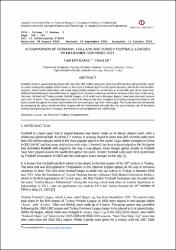| dc.contributor.author | Eryılmaz, Halil | |
| dc.contributor.author | Er, Fikret | |
| dc.date.accessioned | 2019-10-20T09:31:50Z | |
| dc.date.available | 2019-10-20T09:31:50Z | |
| dc.date.issued | 2016 | |
| dc.identifier.issn | 1302-3160 | |
| dc.identifier.uri | http://www.trdizin.gov.tr/publication/paper/detail/TWpJNE16YzNOdz09 | |
| dc.identifier.uri | https://hdl.handle.net/11421/17798 | |
| dc.description.abstract | Football, which is assumed to be played with more than 250 million players in more than 200 countries all around the world, is a sports activity that appeals to the masses. In this respect, football, apart from the sports structure, with its fan communities, sponsors, social media applications and social responsibility projects has turned into an inseparable part of our daily lives. Different football leagues show differences in regards to the sponsor connections and financial powers they have. In this study, Germany, Holland and Turkey premier football leagues, all of which are in European leagues, have been discussed because each have 18 teams. The competitiveness structure of the leagues has been compared by making comparisons based on the points scored throughout the season by the teams that rank among the top three in the league. The results have been interpreted by comparing the above-mentioned three leagues with the fundamental principle that the score increase rate of the teams ranking among the top three in leagues, where there is less competitiveness, will be high. | en_US |
| dc.description.abstract | Football, which is assumed to be played with more than 250 million players in more than 200 countries all around the world, is a sports activity that appeals to the masses. In this respect, football, apart from the sports structure, with its fan communities, sponsors, social media applications and social responsibility projects has turned into an inseparable part of our daily lives. Different football leagues show differences in regards to the sponsor connections and financial powers they have. In this study, Germany, Holland and Turkey premier football leagues, all of which are in European leagues, have been discussed because each have 18 teams. The competitiveness structure of the leagues has been compared by making comparisons based on the points scored throughout the season by the teams that rank among the top three in the league. The results have been interpreted by comparing the above-mentioned three leagues with the fundamental principle that the score increase rate of the teams ranking among the top three in leagues, where there is less competitiveness, will be high. | en_US |
| dc.language.iso | eng | en_US |
| dc.rights | info:eu-repo/semantics/openAccess | en_US |
| dc.subject | Ortak Disiplinler | en_US |
| dc.title | A Comparison of Germany, Holland and Turkey Football Leagues with Cramér-Von Mises Test | en_US |
| dc.type | article | en_US |
| dc.relation.journal | Anadolu Üniversitesi Bilim ve Teknoloji Dergisi :A-Uygulamalı Bilimler ve Mühendislik | en_US |
| dc.contributor.department | Anadolu Üniversitesi, Fen Fakültesi, İstatistik Bölümü | en_US |
| dc.identifier.volume | 17 | en_US |
| dc.identifier.issue | 5 | en_US |
| dc.identifier.startpage | 786 | en_US |
| dc.identifier.endpage | 794 | en_US |
| dc.relation.publicationcategory | Makale - Ulusal Hakemli Dergi - Kurum Öğretim Elemanı | en_US |
| dc.contributor.institutionauthor | Er, Fikret | |


















